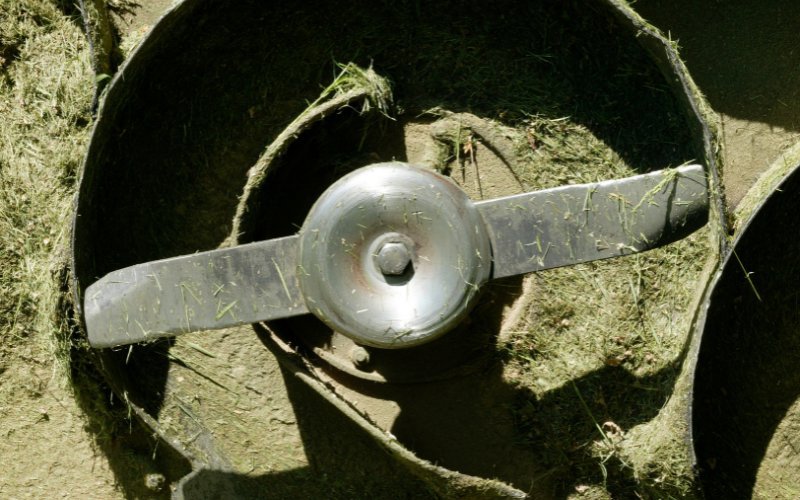If you’ve noticed a change in your mower’s RPM, you may wonder if there’s an actual correct speed your lawn mower’s blade should turn. Knowing how fast a lawn mower blade spins is important because it could help you diagnose if your lawn mower is having a problem or if you’re breaking safety regulations and heading into danger.

Just How Fast Does a Lawn Mower Blade Spin – RMP & MPH (The Short Answer)
Depending on the lawn mower brand and blade specification, the blade should spin at approximately 3000 RPM (revolutions per minute) to cut grass efficiently. In addition, according to ANSI standards, the tip of the blade should spin at a speed no greater than 19,000 feet per minute, approximately 216 MPH (miles per hour).
What Happens If Your Blade Speed is Outside This Range
Lawn mowers have a range of blade RPM that can vary between 2800-3600 RPM. This range will drop once the blade comes into contact with the grass by a few hundred RPM. Therefore, operating calculations take into account two things:
- The required blade speed to efficiently cut the grass
- The physical ability of the lawn mower.
Let’s take a closer look at what this means.
Lawn Mower Blade Too Slow
If your lawn mower’s blade spins below the required speed, then the blade will lose its cutting efficiency. You’ll know the feeling of a slow spinning blade if you have ever forgotten to set the throttle to the maximum setting.
A blade that spins below the designed speed will make unclean cuts and tear the grass. The result is similar to that of grass mowed with dull blades. In addition, if the blade lacks power, the mower will be unable to clear the grass out of the way and get bogged down.
Lawn Mower Blade Too Fast
Safety is the main reason regulations are in place for a lawn mower blade tip’s speed. Lawn mower decks are rigorously tested during the design process, ensuring that in the event that a blade comes loose, it can not penetrate completely through the deck and become a deadly projectile. Governing safety regulations specify that the blade tip speed cannot exceed 216-MPH.
Additionally, all the parts that make up the lawn mower have been specified to work up to a maximum operating speed. Exceeding these limits will cause failure of the lawn mower. So rest assured, those racing lawn mowers do not use standard parts.
Factors that Could Affect How Fast a Mower Blade Spins
Now, different factors can affect how fast your lawn mower blade spins. Let’s take a look at what these could be.
Engine Speed
Engine speed can be incorrectly adjusted with the throttle cable connection. If the cable has too much adjustment to the carburetor, it will increase the engine RPM. The cable adjustment can also be adjusted too low and not be able to reach the desired blade speed.
Blade Length
Mowers are designed to use specific blade lengths. For example, an undersized blade in your mower will be able to move faster because it will have less resistance and weigh less than a longer blade.
Obstructed Blade
Excessive grass buildup and objects wrapped around the blade reduce the blade’s ability to spin freely. As a result, having these obstructions in your mower deck is going to reduce the speed of the lawn mower’s blade RPM.
Grass Length
Long, thick grass will most of the time be above the lawn mower’s cutting ability. Matching your expectations to what your lawn mower can realistically achieve will ensure that you keep the blades spinning at their optimum speed.
Not Handling Maintenance and Repairs
Anytime the lawn mower is neglected, you’ll notice a reduction in performance. Likewise, skipping routine maintenance and repairs will lower the mower’s performance and result in a slower blade speed. Here are some items that could affect how fast your lawn mower blade spins.
- Loose Deck/Blade Belt
- Damaged Pulley
- Broken Tension Spring
- Dirty Air Filter
- Dirty Fuel Filter
- Clogged Fuel Line
- Degraded Spark Plug
- Blunt Blades
- Bad Gasoline
Checking Your Blade Speed
If you dig out your lawn mower manual, you’ll find the engine and blade speed in the small print. Then, with the help of a tool such as a handheld tachometer, you’ll be able to test how fast your mower blade spins and make any adjustments and repairs necessary.


Good article.
You mentioned that a too slow spinning blade does not cut properly and equals a dull blade. Agreed.
How about the reverse? If a sharp blade is running at elevated speeds, will that generate more grass resistance to the blade, where more engine torque would be helpful? Would you have an acceptable speed recommendation above which the grass resistance increases?
Thank you
Hi Floram,
I would say that to maintain blade tip speed, specific torque is required. Therefore increasing the resistance against the blade would increase the need for additional torque/power.
For example, a small lawn mower with limited power requires more time to cut and therefore travels at a slower speed to limit resistance than a larger, more powerful machine.
I don’t have an answer as to the specific resistance/torque requirements to cut different grass thicknesses and densities at varying speeds. I think I would need to call my old physics teacher to answer that question. All I could say is that if you have long, thick grass, you’ll want a sharp blade and a powerful mower, or just go very slowly with a small mower.
Thanks for the question.
Tom.